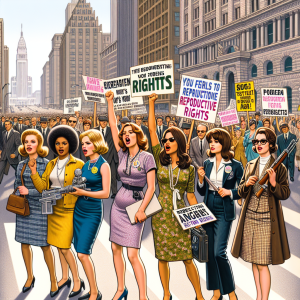#FutureGirls
Welcome to a Time of Change
The 1960s stand out as a period teeming with disruption and significant societal evolution, affecting every aspect of life in the United States. It was a time when movements for the elimination of workplace discrimination were gaining momentum, advocating for gender equality and equal compensation. These initiatives did more than just question the status quo; they fundamentally transformed how society viewed fairness and diversity within the workplace.
Understanding the Battle
To fully appreciate the depth of this change, one must consider the context in which the movements of the 1960s evolved. The American workplace was deeply entrenched in practices that favored certain groups over others based on race and gender, beyond the criteria of skills or qualifications. Women, particularly those of color, found themselves in roles that were undervalued and underpaid, regardless of their competence or ambitions.
– Wage Inequality: The era was characterized by significant pay gaps, with women earning much less than their male counterparts for equivalent work.
– Restricted Advancement: Opportunities for women and minorities were severely limited, often excluding them from higher-paying, esteemed positions.
– Systemic Discrimination: The workplace was rife with policies and practices that openly discriminated based on gender or race, a reflection of broader societal norms.
In this setting, the call for equal pay and rights was not just a plea for workplace improvement but a broader fight for dignity and equality.
Pioneers of Transformation
At the forefront of this narrative were the individuals and organizations brave enough to imagine a different future—one where professional value wasn’t determined by gender or race. Activists, labor unions, and visionary leaders led the charge for change, supported by significant legislative progress, most notably through the Civil Rights Act of 1964 and the Equal Pay Act of 1963. These laws were instrumental in challenging and changing discriminatory practices.
Among the voices that encapsulate the spirit of the time is that of renowned writer and feminist Gloria Steinem:
“The story of women’s struggle for equality belongs to no single feminist nor to any one organization but to the collective efforts of all who care about human rights.”
Steinem’s remark highlights a key aspect of the 1960s movement: it was a shared struggle, surpassing individual goals for the benefit of the larger good.
The Roadblocks and Opposition
The quest for equality was met with considerable resistance. Those opposing the movement for equal pay and rights viewed these changes as a threat to established norms. Resistance came from employers, legislators, and some public sectors, under economic, social, or moral pretenses.
Nevertheless, the movement pressed on, employing protests, persuasive discourse, and legal action to erode the barriers of workplace discrimination. It was a testament to the resilience and determination of those involved, with the movement’s achievements dependent on its ability to garner support and counter opposing views.
Heritage and Continued Efforts
While the strides made during the 1960s in pursuit of workplace equality are significant, the journey towards full parity continues. Pay gaps and unequal opportunities still persist, albeit to a lesser extent, thanks to the efforts of the era.
Reflecting on the enduring relevance of this struggle, human rights campaigner Nada Al-Ahdal remarks:
“We stand on the shoulders of those who came before us, their fight for equality lighting our path forward. The journey is far from over, but their victories remind us that change is possible, one step at a time.” – Nada Al-Ahdal @nadalahdal
Al-Ahdal’s statement serves as a powerful reminder of the perseverance that characterized the 1960s movement and motivates ongoing and future efforts to eradicate workplace discrimination.
Conclusion: An Ongoing Quest
Reflecting on the historic push for equal pay and rights in the 1960s, we recognize that the battle against workplace discrimination is both a legacy we inherit and a journey that persists. Past achievements lay the groundwork and inspire us as we face today’s challenges and those ahead.
The narrative of this era illustrates the influence of collective action and a continuous pursuit of justice, showing us that enduring change is achievable when united by a common cause.
In honoring the 1960s movement, we also accept the ongoing responsibility to advocate for a workplace—and a society—where equality is not an aspiration but a reality experienced by all.
#NadaFoundation
#NadaAlahdal
#Nada_Foundation
#Equal #Pay #Equal #Rights #1960s #Movement #Challenged #Workplace #Discrimination
equal-pay-equal-rights-the-1960s-movement-that-challenged-workplace-discrimination






















